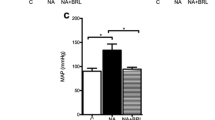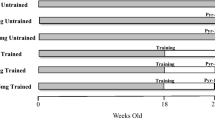Abstract
Physical training induces cardiovascular autonomic nervous system regulation adaptations, which could result from β adrenergic receptor (AR) modifications. Among them, β3 AR alterations have been recently reported but their functional effect remained to discuss. To explain the β3 AR gene expression in relation to function, we simultaneously studied the left ventricle (LV) β3 AR mRNA and protein levels and the myocardial functional effects of a β3 AR agonist following physical training. Forty rats were assigned to either a control (C; N = 20) or a trained (T; N = 20) group. The treadmill running protocol was performed for 8 weeks. Histological measurements on LV slices were quantified. The β3 AR mRNA abundance was studied with RT-PCR and β3 AR protein density with Western-Blot analysis. Myocardial functional effects of a β3 AR agonist, BRL37344 (10−8 M), were studied in Langendorff-perfused hearts. Histological data confirmed the adapted patterns of the physiological cardiac hypertrophy observed in T (P < 0.01), with a significant increase in arteries density (P < 0.01) and an unchanged collagen concentration. The β3 AR protein density was increased in T (154 ± 38% in T vs. 100 ± 24% in C; P < 0.05), but no change was noted concerning the β3 AR mRNA level. After BRL37344 perfusion LVDP, +dP/dT and −dP/dT, in C (P < 0.01), and only +dP/dT in T (P < 0.05) were decreased. Moreover, all LV hemodynamic parameters were more altered after BRL37344 in C than in T (P < 0.01).
Thus, in this physiological model of cardiac hypertrophy, an increase of β3 AR density without β3 AR mRNA alteration was observed. Classical negative myocardial lusitropic and inotropic effects induced by a specific agonist of β3 AR were diminished in trained rats.
Similar content being viewed by others
References
Steinberg SF (1999) The molecular basis for distinct β-adrenergic receptor subtype actions in cardiomyocytes. Circ Res 85:1101–1111
Gauthier C, Tavernier G, Charpentier F, Langin D, Le Marec H (1996) Functional β3-adrenoceptor in the human heart. J Clin Invest 98:556–562
Kitamura T, Orishi K, Dohi K, Okinaka T, Isoka N, Nakano T (2000) The negative inotropic effect of β3 adrenoceptor stimulation in the beating guinea pig heart. J Cardiovasc Pharmacol 35:786–790
Tavernier G, Toumaniantz G, Erfanian M, Heyman MF, Laurent K, Langin D, Gauthier C (2003) β3-adrenergic stimulation produces a decrease of cardiac contractility ex vivo in mice overexpressing the human β3-adrenergic receptor. Cardiovasc Res 59:288–296
Rozec B, Noireaud J, Trochu JN, Gauthier C (2003) Place of β3-adrenoceptor subtypes in the regulation of the cardiac vascular system. Cardiovasc Res 96:905–913
Moniotte S, Vaerman JL, Kockx MM, Larrouy D, Langin D, Noirhomme P, Balligand JL (2001) Real-time RT-PCR for detection of beta-adrenoceptor messenger RNAs in small human endomyocardial biopsies. J Mol Cell Cardiol 33:2121–2133
Cheng HJ, Zhang ZS, Onishi K, Ukai T, Sane DC, Cheng CP (2001) Upregulation of functional β3-adrenergic receptor in the failing canine myocardium. Circ Res 89:599–606
Dinçer ÜD, Bidasee KR, GÜner S, Tay A, Ozçelikay AT, Altan VM (2001) The effect of Diabetes on expression of β1-, β2-, β3-adrenoreceptors in rat hearts. Diabetes 50:455–461
Carré F (2002) Cardiovascular benefits and hazard of physical practice. Ann Cardiol Angeiol 51:351–356
Libonati JR (1999) Myocardial diastolic function and exercise. Med Sci Sports.Exerc 12:1741–1747
Gledhill N, Cox D, Jamnik R (1994) Endurance athletes’stroke volume does not plateau: major advantages is diastolic function. Med Sci Sports Exerc 26:1116–1121
Werle EO, Strobel G, Weicker H (1990) Decrease in cardiac beta1- and beta2-adrenoceptors by training and endurance exercise. Life Sci 46:9–17
Mazzeo RS, Podolin DA, Henry V (1995) Effects of age and endurance training on β-adrenergic receptor characteristics in Fischer 344 rats. Mech Ageing Dev 84:157–169
Hammond HK, White FC, Brunton LL, Longhurst JC (1987) Association of decreased myocardial β-receptors and chronotropic response to isoproterenol and exercise in pigs following chronic dynamic exercise. Circ Res 60:720–726
Barbier J, Rannou-Bekono F, Marchais J, Berthon PM, Delamarche P, Carré F (2004) Effect of training on β1 β2 β3 adrenergic and M2 muscarinic receptors in rat heart. Med Sci Sports Exerc 36:949–954
Essen-Gustafsson B, Henriksson J (1984) Enzyme levels in pools of microdissected human muscle fibbers of identified type. Adaptative response to exercise. Acta Physiol Scand 120:505–515
Lemoine S, Granier P, Toffoche C, Berthon PM, Rannou-Bekono F, Thieulant ML, Carré F, Delamarche P (2002) Effect of endurance training on oestrogen receptor alpha transcripts in rat skeletal muscle. Acta Physiol Scand 174:283–289
Swynghedauw B (1999) Molecular mechanisms of myocardial remodelling. Physiol Rev 79:215–262
Liggett SB, Freedman NJ, Schwinn DA, Lefkowitz RJ (1999) Structural basis for receptor subtype-specific regulation revealed by a chimeric β3-/β2-adrenergic receptor. Proc Natl Acad Sci USA 90:3665–3669
Lafontan M (1994) Differential recruitment and differential regulation by physiological amines of fat cell β1-, β2-, β3-adrenergic receptors expressed in native fat cells and in transfected cell lines. Cell Signal 6:363–392
Paulus WJ (2001) The role of nitric oxide in the failing heart. Heart Fail Rev 6:105–118
Wheeldon NM, Mc Devitt DG, Lipworth BJ (1993) Investigation of putative cardiac β3-adrenoceptors in man. Quaterly J Med 86:255–261
Lankford EB, Korzick DH, Palmer BM, Stauffer BL, Cheung JY, Moore RL (1998) Endurance exercise alters the contractile responsiveness of rat heart to extracellular Na+ and Ca2+. Med Sci Sports Exerc 30:1502–1509
MacDonnell SM, Kubo H, Crabbe DL, Renna BF, Reger PO, Mohara J, Smithwick LA, Koch WJ, Houser SR, Libonati JR (2005) Improved myocardial β-adrenergic responsiveness and signalling with exercise training in hypertension. Circulation 111:3420–3428
Acknowledgements
We thank several people from the Faculty of Medicine, University of Rennes 1, Dr. M. Alizadeh, MD, (Laboratory of Histocompatibility and Immunogenetic) for his help concerning RT-PCR technique, Dr. F. Burtin, MD, Laboratory of Anatomopathology for her helpful advice concerning histological slides and Mr C. Mouas (INSERM U127, Lariboisière Hospital, Paris) for their technical support. We also thank Mr Gerald G. Pope PhD MD (Medical and Scientific translations), for his helpful advice for English translation. This work has been supported in part by a grant from the “Club des Cardiologues du Sport”.
Author information
Authors and Affiliations
Corresponding author
Rights and permissions
About this article
Cite this article
Barbier, J., Rannou-Bekono, F., Marchais, J. et al. Alterations of β3-adrenoceptors expression and their myocardial functional effects in physiological model of chronic exercise-induced cardiac hypertrophy. Mol Cell Biochem 300, 69–75 (2007). https://doi.org/10.1007/s11010-006-9370-9
Received:
Accepted:
Published:
Issue Date:
DOI: https://doi.org/10.1007/s11010-006-9370-9




